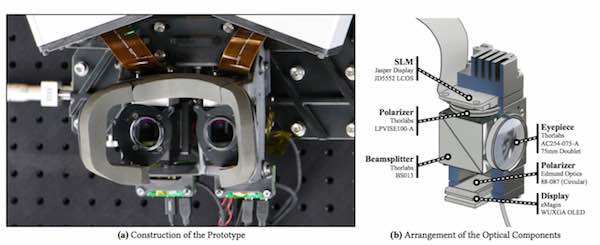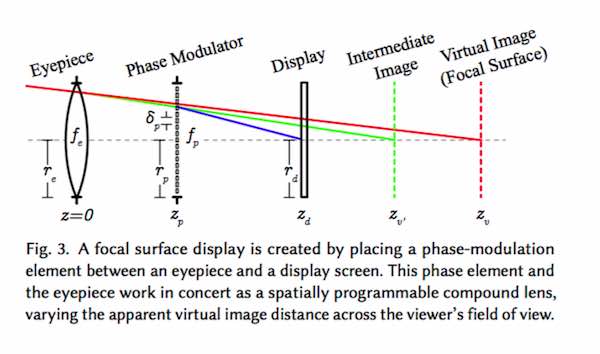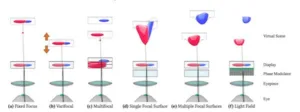If you are going to Siggraph in Los Angeles later this year, you may want to mark your calendar for a talk given by Oculus about a new class of displays they call ‘Focal Surface Display’. Oculus announced the talk directly after being accepted and even published the paper beforehand. The text of the paper can be found here.
According to Oculus they have made a big step forward in solving the vergence – accomodation conflict that has plagued all 3D glasses as well as current VR headsets. As a short reminder, this issue has to do with a discrepancy between the perceived fixed focal plane and the disparity in the two images going to the separate eyes. This issue is responsible for many issues people have when watching stereoscopic 3D content for a elongated time. It may also play a role in the motion thickness that some people experience when using VR headsets.
Display solutions for viewing 3D content
As Oculus explains, there are several approaches to solving this issue. So far, the industry has been looking at the extreme ends of the solution spectrum from fixed focal plane displays to light field and holographic displays. Oculus said that, in their opinion, the high end solutions like light field and holographic displays are currently far away from being viable solutions for consumer devices and will stay this way for some time to come.
In between, there are now emerging varifocal and multifocal displays that improve the issue by shifting or adding more focal planes into the display and thus reducing this particular conflict for the viewer. The new technology step Oculus is describing is the focal surface display (single or multiple surfaces are possible) where the image appears to be projected onto a three dimensional shaped surface. This allows a reduction, or, in the best case, elimination of the vergence – accommodation conflict.
 Schematic and prototype of the Oculus Focal Surface Display
Schematic and prototype of the Oculus Focal Surface Display
The way Oculus achieves this is through a phase modulator placed in between the flat display surface and the eyepiece of a head mounted display. The phase modulator changes the position of the virtual image, allowing the observer to have the eye focus naturally. The phase modulator is a spatial light modulator (LCOS device) that is now becoming available in the market.
 Functionality of the Oculus Focal Surface Display
Functionality of the Oculus Focal Surface Display
Overall this is a very interesting approach and Oculus said that it has succeeded in building a prototype as a proof of concept as it shows in the images. Oculus also published a YouTube video that explains what the display does. For more technical details the published paper delivers more facts and results. (NH)
Analyst Comment
The vergence/accomodation conflict has long been an issue. Lightfield displays have the promise of solving this, but, as Oculus has pointed out, at the expense of huge amounts of bandwidth, and that is always a challenge, but especially in mobile and lightweight applications where power consumption is limited. The Oculus approach certainly looks very interesting and it could well slow down the push to lightfield displays. (BR)

